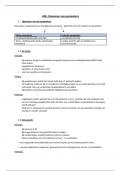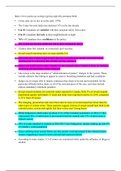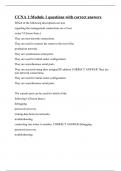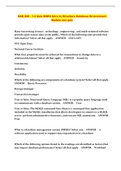Task 5
How do Polygraph tests work?
- Polygraphs (lie detector): measure psychophysiological responses to detect deception
most common used technique: Control Questions Test (CQT)
still widely used in criminal investigations (at least in USA and Canada)
For a test to be admissible in court it must satisfy the Daubert criteria (testability, known error rate,
peer review and publication, general acceptance)
During the question/answer session the polygraph monitors the examinee's physiological
responses that include:
o electrodermal activity (i.e., skin conductance)
o changes in pattern of respiration
o changes in cardiovascular measure (e.g., blood pressure and heart rate)
o (some also look at movement – mostly to prevent suspects using countermeasures)
Are Polygraphs effective?
-Accuracy rates are high, but there is often no ground truth and studies have several important limitations.
-Therefore, it is hard to judge whether polygraphs are effective.
In general, polygraphs are often perceived as not accurate.
-The extent to which deception can be inferred from the polygraph examination is dependent on the degree to
which the examiner can ensure that the arousal engendered by the questions being asked is caused by deception
rather than some other factor
-This dependence on examiner competence, and the associated implication of a lack of standardization in polygraph
testing, has been put forward as a reason for rejecting the ‘scientific’ standing of polygraphy
Meijer during the tutorial:
Policemen have trust in the lie detector; they think that it is very accurate. This leads to:
- False positive: lie detector says that the person is guilty (failed the polygraph), but during the interview, there
is no confession. However, no confession does not prove that you made an error. The police will not do any
further investigation to find the perpetrator, but they will continue until they elicit a confession from their
current suspect.
- False negative: lie detector says that person is innocent, but person is in fact guilty. If the suspect is sent home,
the perpetrator is never found so the perpetrator is missed.
- National research council (2003): polygraph tests can discriminate lying from truth telling at rates well
above chance, though well below perfection
- ~Error rates could be considered significant
- Conclusion: The accuracy of the CQT is unknown (above chance and below perfection)
What is the Control Question Test/Comparison Question Test (CQT)?
-Control or comparison question test is a procedure that is widely used in forensic settings
-It involves comparing the response to crime-relevant questions (RQ) with irrelevant questions covering
inconsequential topics for which the correct answer was readily apparent
-The CQT replaced the irrelevant query with a comparison question
1
, - 3 type of questions:
Relevant questions (RQ): specific to the crime ("Did you steel the money"?)
Comparison/Control (CQ): addresses previous misconduct without asking or referring to the actual
crime/ are assumed to elicit at least as much emotion as the relevant questions do for an innocent
suspect ("Earlier in your life, have you ever taken anything that wasn't yours?")
Neutral/Irrelevant: general and unrelated to the crime (e.g., "Is today Monday?")
-An examinee is instructed to always answer with "no"
If the psychophysiological responses are greater to relevant questions than to control questions, then the suspect
is considered to lie about the relevant questions and thus guilty of the crime
-Questions are asked 3-4 times
- Basic assumption of CQT:
RQ has a higher significance for guilty subjects (guilty subjects show stronger responses to RQ)
CQ has a higher significance for innocent subjects (innocent people show stronger responses to CQ)
physiological responses to relevant questions (RQ) and comparison questions (CQ) are compared
these differences in the perceived significance will elicit different responses for guilty and innocent
suspects
when consistent differences are found the examiner infers either that the subject lies or that s/he is
telling the truth
- The CQT consists of 3 phases:
(1) Pre-test interview: examiner tries to gain more information about the examinee in order to
formulate proper CQs
examiner stresses that the CQs are as important as the RQs is supposed to lead to a shift
in the personal relevance of the two types of questions (innocent CQ, guilty RQ)
A proper CQ must elicit a potential lie in innocent people or at least concern them when
asked in order to achieve strong enough responses
(2) Actual CQT examination: in this phase the examinee is asked all the questions while her/his
physiological responses are monitored
Some examiners will also include a Slim test: procedure designed to convince subjects
they will be caught if they lie
subject may be asked to choose a card from a marked deck or to write down a number
between 1 and 10 and place it face up so both the subject and examiner can see it
examiner then asks the subject if he has selected any of a series of cards or numbers,
including the chosen one, to see if the physiological reactions are strongest to the
subject’s pick
(3) Confrontation (only for subjects who failed the examination): examinee is confronted with the
failed outcome in order to elicit a confession
Major problems with the CQT:
It is biased against the innocent (innocent people are more likely to fail than are guilty individuals to
pass)
Assumptions on which the CQT is based on are hard to justify
The measured physiological reactions are the same when lying or afraid/stressed of falsely being
accused and therefore cannot be discriminated from each other
o CQT lacks a theoretical foundation:
it does not have any theoretical basis that justifies the assumed relationship between
physiological changes and deception
there is no specific "lie response" no pattern of responses that is unique to deception
o The CQT is not a standard test:
2
How do Polygraph tests work?
- Polygraphs (lie detector): measure psychophysiological responses to detect deception
most common used technique: Control Questions Test (CQT)
still widely used in criminal investigations (at least in USA and Canada)
For a test to be admissible in court it must satisfy the Daubert criteria (testability, known error rate,
peer review and publication, general acceptance)
During the question/answer session the polygraph monitors the examinee's physiological
responses that include:
o electrodermal activity (i.e., skin conductance)
o changes in pattern of respiration
o changes in cardiovascular measure (e.g., blood pressure and heart rate)
o (some also look at movement – mostly to prevent suspects using countermeasures)
Are Polygraphs effective?
-Accuracy rates are high, but there is often no ground truth and studies have several important limitations.
-Therefore, it is hard to judge whether polygraphs are effective.
In general, polygraphs are often perceived as not accurate.
-The extent to which deception can be inferred from the polygraph examination is dependent on the degree to
which the examiner can ensure that the arousal engendered by the questions being asked is caused by deception
rather than some other factor
-This dependence on examiner competence, and the associated implication of a lack of standardization in polygraph
testing, has been put forward as a reason for rejecting the ‘scientific’ standing of polygraphy
Meijer during the tutorial:
Policemen have trust in the lie detector; they think that it is very accurate. This leads to:
- False positive: lie detector says that the person is guilty (failed the polygraph), but during the interview, there
is no confession. However, no confession does not prove that you made an error. The police will not do any
further investigation to find the perpetrator, but they will continue until they elicit a confession from their
current suspect.
- False negative: lie detector says that person is innocent, but person is in fact guilty. If the suspect is sent home,
the perpetrator is never found so the perpetrator is missed.
- National research council (2003): polygraph tests can discriminate lying from truth telling at rates well
above chance, though well below perfection
- ~Error rates could be considered significant
- Conclusion: The accuracy of the CQT is unknown (above chance and below perfection)
What is the Control Question Test/Comparison Question Test (CQT)?
-Control or comparison question test is a procedure that is widely used in forensic settings
-It involves comparing the response to crime-relevant questions (RQ) with irrelevant questions covering
inconsequential topics for which the correct answer was readily apparent
-The CQT replaced the irrelevant query with a comparison question
1
, - 3 type of questions:
Relevant questions (RQ): specific to the crime ("Did you steel the money"?)
Comparison/Control (CQ): addresses previous misconduct without asking or referring to the actual
crime/ are assumed to elicit at least as much emotion as the relevant questions do for an innocent
suspect ("Earlier in your life, have you ever taken anything that wasn't yours?")
Neutral/Irrelevant: general and unrelated to the crime (e.g., "Is today Monday?")
-An examinee is instructed to always answer with "no"
If the psychophysiological responses are greater to relevant questions than to control questions, then the suspect
is considered to lie about the relevant questions and thus guilty of the crime
-Questions are asked 3-4 times
- Basic assumption of CQT:
RQ has a higher significance for guilty subjects (guilty subjects show stronger responses to RQ)
CQ has a higher significance for innocent subjects (innocent people show stronger responses to CQ)
physiological responses to relevant questions (RQ) and comparison questions (CQ) are compared
these differences in the perceived significance will elicit different responses for guilty and innocent
suspects
when consistent differences are found the examiner infers either that the subject lies or that s/he is
telling the truth
- The CQT consists of 3 phases:
(1) Pre-test interview: examiner tries to gain more information about the examinee in order to
formulate proper CQs
examiner stresses that the CQs are as important as the RQs is supposed to lead to a shift
in the personal relevance of the two types of questions (innocent CQ, guilty RQ)
A proper CQ must elicit a potential lie in innocent people or at least concern them when
asked in order to achieve strong enough responses
(2) Actual CQT examination: in this phase the examinee is asked all the questions while her/his
physiological responses are monitored
Some examiners will also include a Slim test: procedure designed to convince subjects
they will be caught if they lie
subject may be asked to choose a card from a marked deck or to write down a number
between 1 and 10 and place it face up so both the subject and examiner can see it
examiner then asks the subject if he has selected any of a series of cards or numbers,
including the chosen one, to see if the physiological reactions are strongest to the
subject’s pick
(3) Confrontation (only for subjects who failed the examination): examinee is confronted with the
failed outcome in order to elicit a confession
Major problems with the CQT:
It is biased against the innocent (innocent people are more likely to fail than are guilty individuals to
pass)
Assumptions on which the CQT is based on are hard to justify
The measured physiological reactions are the same when lying or afraid/stressed of falsely being
accused and therefore cannot be discriminated from each other
o CQT lacks a theoretical foundation:
it does not have any theoretical basis that justifies the assumed relationship between
physiological changes and deception
there is no specific "lie response" no pattern of responses that is unique to deception
o The CQT is not a standard test:
2











